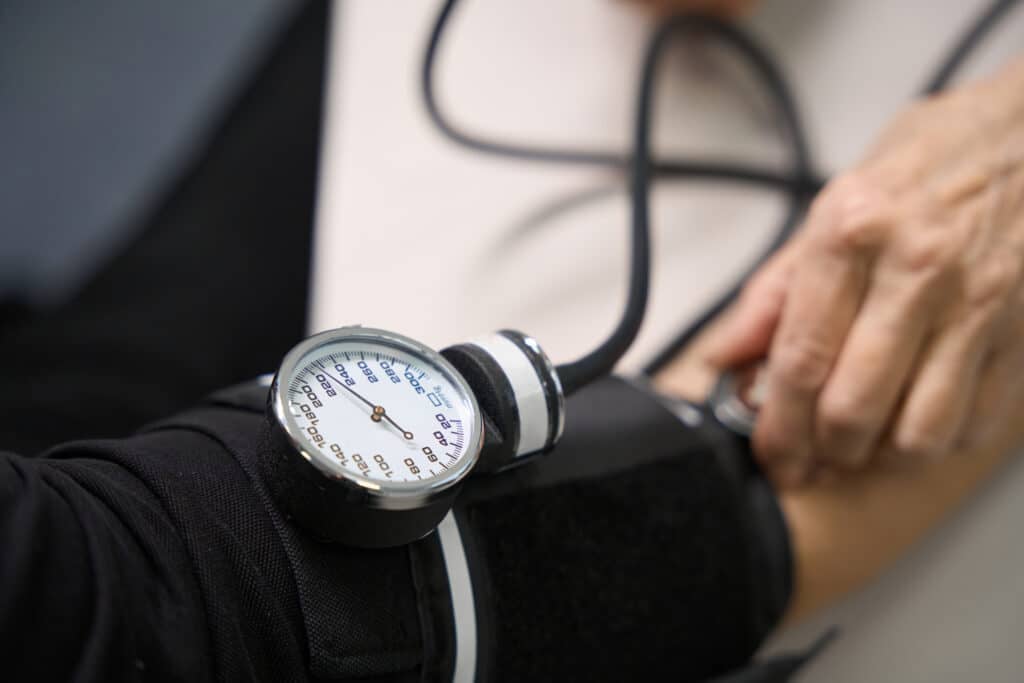Hypertension, also known as high blood pressure, is a chronic medical condition affecting over a billion people globally. Often referred to as the “silent killer,” hypertension is dangerous because it can persist for years without noticeable symptoms, only revealing itself through complications such as heart disease, stroke, and kidney damage. It is crucial to understand hypertension’s causes, symptoms, risk factors, and treatment to manage this condition effectively and reduce associated health risks. In many circumstances, uncontrolled hypertension may qualify as a serious health condition allowing for job protected medical leave under the FMLA.
Hypertension occurs when blood pressure consistently exceeds normal ranges, meaning the heart must work harder to pump blood through the blood vessels. The pressure in adults is measured as two values: systolic blood pressure (the pressure exerted when the heart beats) and diastolic blood pressure (the pressure exerted when the heart rests between beats). According to the American Heart Association and the National Heart, Lung, and Blood Institute, normal blood pressure in adults is under 120/80 mm Hg. Elevated blood pressure readings that consistently exceed these values (130/80 mm Hg or higher) indicate hypertension.
Hypertension impacts the flow of blood throughout the body, straining the walls of blood vessels and increasing the workload on the heart muscle. This excess strain can lead to arterial damage and conditions such as coronary heart disease, congestive heart failure, and systemic hypertension. Hypertension’s effects are cumulative and severe if left untreated, making early diagnosis and intervention crucial.

Hypertension can be classified as either primary (essential) hypertension or secondary hypertension, each with distinct causes.
Primary hypertension accounts for around 90-95% of all hypertension cases. Its exact cause remains unknown, though it is often linked to lifestyle factors, genetic predispositions, and environmental factors that affect blood vessel function and pressure regulation. A common condition among older adults, essential hypertension typically develops gradually over time.
Unlike primary hypertension, secondary hypertension has identifiable causes. It is often the result of an underlying condition, such as chronic kidney disease, adrenal hyperplasia, or renal artery stenosis. Additionally, certain medications (like corticosteroids and birth control pills) and substances (e.g., recreational drugs) can lead to secondary hypertension. Management of secondary hypertension involves addressing these underlying causes, which often leads to blood pressure reduction.
Certain risk factors contribute to the development of hypertension, ranging from genetics to lifestyle choices and environmental influences. Understanding these risk factors can help in preventing and managing high blood pressure.
Family history plays a significant role in hypertension risk. Specific genetic factors may influence the body’s regulation of blood pressure and how it responds to environmental stressors.
The prevalence of hypertension increases with age. Blood vessel walls often become less flexible over time, causing the heart to work harder to pump blood effectively. Age-related changes, especially in people aged 60 and older, are a major contributor to hypertension.
Excess weight strains the cardiovascular system, increasing blood pressure as the heart must work harder to supply blood to additional body tissue. Maintaining a healthy weight is essential for blood pressure control and reducing hypertension risk.

Physical inactivity can lead to weight gain, poor cardiovascular health, and weakened heart function. A sedentary lifestyle contributes to high blood pressure and is a common factor for hypertension in adults.
Excess sodium in the diet leads to water retention, increasing blood volume and pressure on arterial walls. This response makes salt reduction a key dietary change for those managing or at risk for hypertension.
Diets high in saturated fats, processed foods, and alcohol can lead to high blood pressure and other cardiovascular issues. Limiting alcohol intake and prioritizing a nutrient-rich, low-sodium diet can help prevent hypertension.
Pollution, chronic stress, lack of physical activity, and unhealthy lifestyle choices (like smoking) are additional factors that may contribute to hypertension.

Hypertension is often called a “silent killer” because it can develop without noticeable symptoms until severe complications arise. However, certain symptoms may indicate high blood pressure, particularly during a hypertensive crisis.
Most people with hypertension experience no symptoms, underscoring the importance of regular blood pressure checks. Mild cases often go undiagnosed until other health issues, such as heart disease or kidney damage, occur. Some people may experience symptoms like headaches, dizziness, or shortness of breath, but these symptoms are non-specific.
In cases of dangerously high blood pressure, known as a hypertensive crisis (often defined as blood pressure readings above 180/120 mm Hg), more severe symptoms can occur. These include chest pain, vision changes, severe headaches, shortness of breath, and confusion. A hypertensive crisis may lead to hypertensive encephalopathy (brain injury), heart failure, or stroke and requires immediate medical attention to prevent life-threatening outcomes.
Diagnosing hypertension requires accurate blood pressure measurement and a comprehensive evaluation of individual health history.
Blood pressure is typically measured using a blood pressure cuff. To ensure an accurate reading, multiple measurements are taken on separate occasions, as temporary factors (like stress or “white coat hypertension” induced by doctor visits) can elevate readings. Blood pressure monitors for home use can provide additional data points, especially for those with suspected masked hypertension or labile blood pressure.
Diagnosis and treatment of hypertension follow standardized guidelines provided by the American Heart Association, and other health organizations. These guidelines outline blood pressure goals based on factors like age, medical history, and individual risk of heart disease. Normal blood pressure, as well as prehypertension and hypertension stages, are defined to help healthcare professionals create individualized treatment plans.

Treatment for hypertension typically combines lifestyle modifications and, in some cases, medication. The goal is to lower blood pressure to a normal range and prevent complications.

When lifestyle changes are insufficient, antihypertensive medications are prescribed to achieve target blood pressure levels. Common blood pressure medicines include:
Regular blood pressure checks and adherence to prescribed blood pressure medications are essential for effective management. Patients should work closely with their healthcare providers to monitor progress and adjust treatment as needed.
Ongoing management of hypertension is necessary to prevent complications and maintain quality of life.
Blood pressure should be checked regularly, either at a doctor’s office or with home blood pressure monitors. Monitoring allows for adjustments in treatment and helps detect changes in blood pressure trends.
Chronic stress can elevate blood pressure. Techniques such as mindfulness, meditation, and deep breathing exercises can reduce stress and support blood pressure control.
Skipping doses or stopping medication can lead to uncontrolled hypertension and increase the risk of serious complications. Consistent adherence to blood pressure drugs as prescribed is crucial for successful management.
Without proper treatment, hypertension can lead to life-threatening complications and damage to various organs.
Hypertension is a leading cause of coronary heart disease, left ventricular hypertrophy, and congestive heart failure. Chronic high blood pressure forces the heart to work harder, leading to the thickening of heart muscle and impaired heart function.
Persistently high blood pressure damages blood vessel walls, increasing the risk of blood clots and blockages in the arteries supplying the brain, potentially leading to ischemic stroke. In other cases, high blood pressure can cause the vessels to rupture, resulting in hemorrhagic stroke.
High blood pressure can damage blood vessels in the kidneys, leading to chronic kidney disease and renal failure. Patients with hypertension are at a greater risk of developing renal artery stenosis, further impairing kidney function.
An emergency condition characterized by extremely high blood pressure, hypertensive crisis can result in organ damage, heart attack, or stroke if left untreated. Hypertensive emergency and urgency are severe forms that require immediate medical intervention.


Hypertension is a common condition that requires vigilant management and lifestyle adjustments to prevent serious health complications. A combination of a healthy diet, regular physical activity, medication adherence, and routine monitoring can help individuals control their blood pressure. By understanding risk factors and taking proactive measures, individuals can significantly reduce their risk of complications and maintain a healthy life.
If you are experiencing ongoing symptoms of hypertension that are affecting your job performance, you may qualify for FMLA leave on a continuous or intermittent basis. In addition, you may be eligible for workplace accommodations through the Americans with Disabilities Act (ADA). Reach out to the physicians at myFMLA for a consultation and assistance with FMLA certification, short term disability or ADA accommodations.
Copyright © 2025 myFMLA. All Rights Reserved. Powered by Ventnor Web Agency.